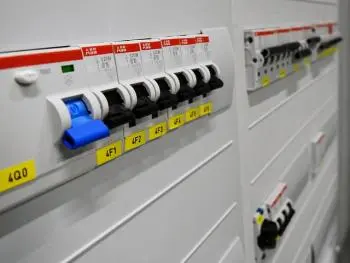
Electrical switches are fundamental elements in electricity and electrical circuits.
Its main function is to control the flow of electrical current, allowing circuits to be turned on or off, devices to be connected or disconnected, ensuring safety and providing control over the electrical supply.
What are electrical switches used for?
The switches have several functions and applications in the electrical field. Here are some of its main utilities:
1. On-off control
The most basic purpose of a switch is to allow control of the flow of electrical power. By opening or closing a switch, electrical devices or circuits can be turned on or off as needed.
This is especially useful in room lighting, where light switches allow us to conveniently control lights.
2. Protection and security
Switches also play a crucial role in protecting electrical circuits and equipment.
Thermomagnetic switches, for example, are used to interrupt the flow of current in the event of overloads or short circuits, avoiding damage to the cables and preventing possible fires.
Differential switches are responsible for detecting current leakage to earth, which helps protect people from electric shock and possible accidents.
3. Energy saving
Electrical switches allow electrical devices or circuits to be turned off when they are not in use, which contributes to energy savings.
By turning off lights, appliances or electronic equipment using a switch, you avoid unnecessary electricity consumption, which has a positive impact on both the environment and the cost of your energy bill.
4. Remote control and automation
The evolution of home automation has made it possible to control and automate devices.
Smart switches, for example, can be controlled via mobile devices or voice assistants, providing convenience and flexibility in power management in home or commercial settings.
5. Circuit segmentation
These devices are also used to segment electrical circuits, allowing for more targeted and efficient control.
For example, in an electrical distribution panel, switches are used to divide the electrical load into different circuits. This division facilitates maintenance, problem identification and independent control of different areas or devices.
Switch Examples
Thermomagnetic switch
The thermomagnetic switch is a protection device used in electrical circuits to interrupt the flow of current when dangerous conditions are detected.
It combines a thermal device, which detects overheating due to excessive currents, and a magnetic device, which detects short-circuit currents. These switches are essential to prevent circuit damage and prevent fires.
Light switch
The light switch is one of the most common and simple types. Allows you to control turning lights on and off in a specific room or area.
Light switches can be toggle, rocker or touch, and are essential to provide lighting according to our needs and save energy.
Security switch
Safety switches are devices designed to protect people and equipment from electrical hazards.
These switches, like the omnipolar breakers, are used in electrical installations to ensure that the circuit is completely disconnected and isolated during maintenance work or in the event of an electrical emergency.
Diferential switch
The differential, also known as an earth leakage switch or earth fault circuit breaker, is a safety device that detects leakage current to earth.
Its function is to interrupt the electrical circuit when a leak occurs, thus avoiding electric shocks and protecting people against risks of electrocution.
Connections between switches
In many electrical installations, especially in large spaces or with multiple access points, it is necessary to have connections between switches. Connections are made for more efficient and versatile control of lighting or electrical devices.
These connections allow you to turn a light or set of lights on or off from several different points, no matter where you are in the circuit.
three way switches
One of the most common connections is the connection of three-way switches. This type of connection is used when you want to control a light from two different locations, such as on a stairwell with switches at the bottom and top.
In this case, two three-way switches are used together with one four-way switch. The three-way switches are interconnected so that the light can be turned on or off from any of the two points.
To accomplish this connection, the common terminals (commonly marked "COM") on the three-way switches must be identified and connected together.
The input and output terminals (marked "L1" and "L2") are then connected to the other terminals of the three-way switches and the four-way switch if used. This allows current to flow between switches and control lighting from different locations.
Types of electrical switches
There are different types of electrical switches that are used in various applications. Some common examples include:
-
Lever: This is one of the most basic and popular types. It consists of a lever that can be moved up or down to open or close the circuit.
-
Button: These are momentary devices that are activated by pressing a button. They are used in situations where momentary control is needed, such as doorbells or on/off pushbuttons.
-
Rocker: it has a lever that can be moved to one side or the other to open or close the circuit. They are widely used in applications where a stable change of state is required, such as on/off switches in household appliances.
-
Touch: They use capacitive technology to detect human contact. They have no moving parts and are activated with a simple touch. They are becoming increasingly popular in home automation and lighting control applications.